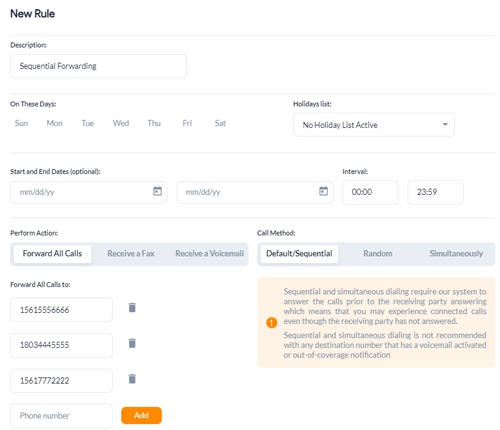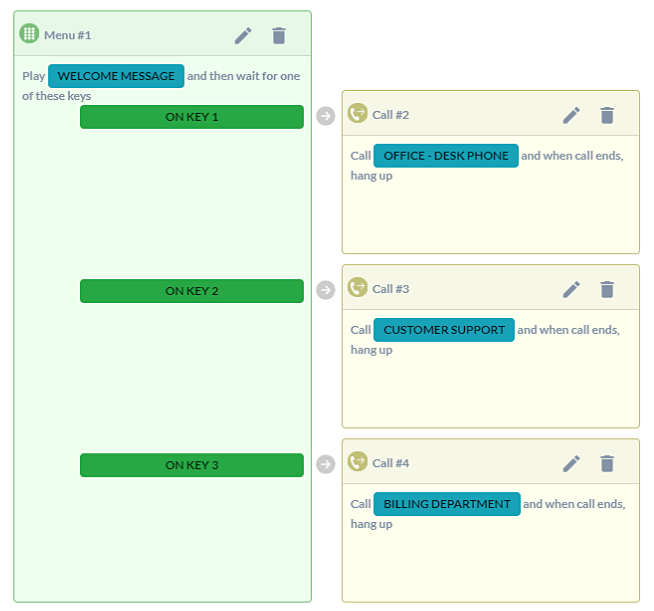In today’s fast-paced business landscape, round-the-clock customer support is a strategic necessity. If phone support is your preferred customer service approach, then you need to ensure customers can effortlessly connect with you. Not only that, you must also be able to quickly resolve their queries, in a responsive and well-organized manner.
An efficient customer support system is paramount, and one integral aspect of this system is the escalation matrix. An escalation matrix offers a meticulous approach to navigating and resolving customer issues. It helps in delineating stages of escalation and identifying agents and teams for handling incidents. With an escalation matrix, you can solve issues systematically and more swiftly. You can use such a matrix for inbound and/or blended call centers.
In this article, we’ll delve into:
- What is an Escalation Matrix? Why is it Important?
- Types of Escalation Models: Failover, Hierarchical, and Functional
- How to Design a Call Center Matrix
- Designing an Escalation Matrix with GCF
Let’s dive in!
What is an Escalation Matrix?
An escalation matrix is a structured framework that guides how to handle challenging customer issues when the first point of contact cannot solve them. Think of it as a ladder helping agents climb to the right level of support to solve complex problems.
Simply put, an escalation matrix outlines the steps and levels of escalation for addressing complex customer issues. By doing so, it ensures that no matter the complexity of the problem, customers can find resolution quickly.
And, it goes without saying, that customers would prefer this instead of being bounced around or left frustrated.
Why is it Important to Have an Escalation Matrix?
As one of the most common call center best practices, the primary goal of any escalation matrix is to enhance customer satisfaction by streamlining the resolution processes. It acts as a safety net, assuring customers that even if their initial concern isn’t resolved, there’s a clear path to reach higher-ups who can provide solutions. Here are some reasons why a well-structured escalation matrix is crucial:
- Minimize time taken for resolution: Ensure that customer issues are handled most efficiently by appropriate and knowledgeable agents,
- Increase the likelihood of retention: Showcase the company’s commitment to customer well-being,
- Optimize resources: Route issues to suitable agents or level of expertise and prevent unnecessary involvement of higher-ups for routine matters.
- Establish clear communication pathways: Ensure that the right information reaches the right people at the right time.
Implementing an escalation matrix helps prepare agents to assist and support callers, no matter what their reason to call.
Related: Call Center Trends in 2023
Types of Escalation Models
These models vary based on your organization’s structure, industry, and customer service priorities. You will have to customize these models to fit your specific needs and industry standards. Here are the most common type of escalation matrix modes:

1) Failover Escalation Matrix: Ring Groups-Based
In this call center escalation model, you can add relevant individuals in respective ring groups and then ring them sequentially. Here’s how:
Group 1 – Frontline Agents: Receive initial call.
Group 2 – Backup Remote Agents: If call remains unanswered.
Group 3 – Support Managers or Director: If call remains unanswered.
Group 4 – Voicemail: If no one answers after that, automatically send callers to a voicemail.

2) Hierarchical Escalation Matrix: Complexity-Based
In this escalation model, customer enquiries start with frontline agents. However, if they cannot resolve the issue, enquiries are escalated step by step to higher levels of expertise. Certain customer support issues may require everyone to pitch in. Here’s a simplified breakdown of a hierarchical escalation matrix:
Level 1 – Frontline Support: Initial contact point where customer concerns arrive; agents can resolve basic issues here.
Level 2 – Technical Support: Forward more complex issues here. These agents possess specialized technical knowledge.
Level 3 – Specialist Teams: Reserved for highly complex issues requiring specialized knowledge or departmental intervention.
Level 4 – Management: Reserved for critical issues requiring immediate attention from higher management.

3) Functional Escalation Matrix: Function-Based
This type of escalation matrix focuses on the functional aspect of the issue rather than the hierarchy. It’s suitable for organizations where specialized teams handle specific types of problems. Here’s a simplified representation:
Function 1 – Network Issues: Escalated when the problem pertains to network connectivity or signal quality.
Function 2 – Billing Concerns: For issues related to billing, payments, and account discrepancies.
Function 3 – Technical Hardware: When the problem involves malfunctioning devices or equipment.
Function 4 – Service Outages: Reserved for widespread service disruptions affecting multiple customers.
Designing a Call Center Matrix
So, how do you design an escalation matrix in your call center? In most cases, you start by identifying what your customers need and then putting plans in place to help them. But depending on your business type and size, you might want to consider a few more factors. Let’s have a look:
Step 1: Identify Customer Issues
First, make a list of common problems customers might face. These could be things like account check-ins, billing issues, product defects, delivery delays, or technical glitches. Understanding these customer pain points helps you organize the escalation process better.
For instance, you can review past customer support tickets to spot recurring challenges. Then identify patterns or keywords within these tickets pointing to common problems.
Or, agents can inquire about customers’ overall experience and if they encountered any difficulties. They can do this by conducting quick and brief surveys to gather customer feedback after providing assistance.
Additionally, they can study feedback gathered from customer surveys and other sources online reviews, social media, etc., for comments and ratings addressing specific issues.
If you offer phone support, then it is recommended that you monitor and analyze call data to identify concerns commonly arising during customer calls.
Step 2: Define Escalation Levels
Once you’ve collected data on the different areas of support you need, you can start building your escalation matrix. Think of escalation levels as different stages of help.
For the failover or hierarchical escalation matrix: Level 1 can tackle basic issues that frontline agents can handle, like password resets. Level 2 can handle trickier issues that need more experienced agents. And Level 3 might involve problems that require the attention of supervisors or managers.
For the functional escalation matrix: Based on the functions needed to resolve common queries, include key departments or individuals within your inbound call center matrix.
Divide and categorize your most common and crucial customer queries. Then, place them in their respective levels. Once you’ve outlined this, you can move on to assign responsibility.
Step 3: Assign Responsibility
For each level, decide who will (and more importantly, who has the relevant experience to) handle the issues. Frontline agents will handle Level 1, while more experienced agents step in for Level 2. If it’s still not resolved, managers might take over at Level 3.
Same goes for the function-based escalations where specific departments handle their queries relevant to them. This ensures problems get to the right people at the right time.
Step 4: Set Time Limits
Time is crucial in customer service. Decide how quickly each level should respond. For instance, Level 1 might need a response within 2 hours, Level 2 within 4 hours, and Level 3 within 24 hours. This keeps customers from waiting too long for solutions.
Share these realistic expectations with your agents and provide them resources — like a knowledge base or unique phone extensions to reach managers — that help meet these goals.
Step 5: Optimize Communication Channels
Decide how customers can reach each escalation level. For simple issues, phone or chat might work. But for complex problems, email or even in-person support might be necessary. Make sure customers know how to reach each level. Ensure your phone number and chat is easy to locate. Set up automated responses so customers know their messages have been received.
Step 6: Create a Clear Flowchart
Now, make a flowchart that shows the path from Level 1 to Level 3. It’s like a map that guides agents on what to do when a problem arises. The flowchart should be simple to understand, so everyone can follow it without confusion. Make sure to include back-up options, in case primary options fail to work.
Step 7: Train and Provide Guidelines
Train your agents on how the escalation matrix works. They should know when to escalate and what information to provide at each level. Guidelines can help them make the right decisions and provide consistent support. It’s important they know how to access relevant information and resources to help resolve queries effectively.
Step 8: Review Regularly, Prioritize Feedback, and Empower Teams
Customer issues change over time, so your escalation matrix should too. Regularly review and update it. If they often feel problems weren’t solved properly, it might be time to rethink your escalation process. Their feedback is invaluable.
Listen to your customers. Continue to survey customers and collect feedback to improve your operational efficiency. If you notice certain issues always go to Level 3, maybe you need to adjust the process. Flexibility is key.
On top of that, take time to empower your agents to make the right decisions. Sometimes, a frontline agent can solve a Level 2 problem with the right tools. This helps save time and enhances customer satisfaction.
Keep communication open. If agents find that certain problems keep coming up, they should feel comfortable providing feedback. This can help refine the escalation matrix for better efficiency.
How to Design a Call Center Escalation Matrix with GCF
So, what options do you have with Global Call Forwarding? Our advanced suite of features—mostly focused on cloud-based forwarding and routing—help you create custom call flows. And this means, you can tailor your escalation matrix based on your specific needs.
With our range of call center technologies, we can help you build this with our 24/7 tech support team and customer success managers.
Here are two ways you can build your call center escalation matrix in our control panel:
1. Ring Groups
You can use ring groups to provide different levels of support. Then, if the first group cannot answer the call, it automatically forwards to the next in line. All this happens quickly behind the scenes so customers don’t have to wait in line for too long.
Here’s what this looks like:

Customize these ring groups to meet your requirements. They can be functional or hierarchical or simply backup options on high call traffic days.
2. IVR and Advanced Routing
Alternatively, you can create a department or function-specific escalation matrix through our IVR editor. Here, you can include relevant functions for common queries like:
- Front desk – for office hours, directions, etc.
- Sales – to increase call center sales
- Customer support – connects to customer support ring groups sequentially as programmed above
- Billing – for billing and accounting-related queries, and so on.
In our control panel, it looks something like this:

Create Custom Call Flows to Prepare for Escalations
Streamlining customer support helps in optimizing your resources and enhancing communication pathways. Global Call Forwarding offers advanced cloud-based solutions for building an efficient escalation matrix. With options like ring groups and IVR, we can help you streamline support thereby helping you to foster customer satisfaction, which ultimately fuels business growth.
To unlock the potential for enhanced customer support and business growth, reach out to Global Call Forwarding today! Speak to our experts today or book a demo.
Related: Cloud Call Center Software – Pricing Guide


